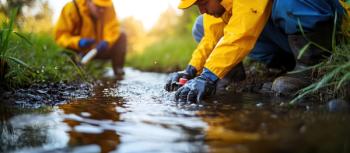
Environmental Analysis
Latest News


New Imaging Techniques Explored to Assess Quality of Sustainable Fertilizers

New Machine Learning Model Distinguishes Recycled PET with 10% Accuracy Threshold
Latest Videos
More News

In this interview segment, Pooja Sheevam elaborates on what LWIR and SWIR are and what advantages they both offer when analyzing Hawaiian geology.

A new study published in Marine Pollution Bulletin reveals significant microplastic contamination at 5000-meter depths in the Central Indian Ocean Basin, highlighting the widespread reach of plastic pollution and the urgent need for regulatory action.

Researchers from Tohoku University, Shibaura Institute of Technology, and Shizuoka University unveil advanced sorting system using NIR, THz, and machine learning for improved recycling outcomes.

A study published in Chemosphere by researchers at the Technical University of Denmark demonstrates that fluorescence spectroscopy can serve as a rapid, on-site screening tool for detecting pharmaceutical contaminants in groundwater.

Researchers from several Chinese universities have developed a low-cost, red mud-based catalyst doped with manganese oxides that efficiently oxidizes toluene at lower temperatures, offering a sustainable solution for air pollution control and industrial waste reuse.

Researchers at the Sinopec Research Institute have developed a novel method using virtually generated mid-infrared spectra to accurately quantify plastic blends, offering a faster, scalable solution for recycling and environmental monitoring.

Webinar Date/Time: Tue, Jun 10, 2025 11:00 AM EDT

A new study published in Chemosphere by researchers at Bharathidasan University reveals alarming seasonal microplastic (MP) contamination in fish and shellfish from India's Pichavaram Mangroves.

A recent review article highlights the promise of near-infrared (NIR) spectroscopy for on-farm analysis of liquid organic manure.

A new study published in Geoderma Regional by J. A. Arias-Rios and colleagues at IFAB demonstrates that near-infrared (NIR) spectroscopy is a rapid, cost-effective tool for assessing soil and tree traits critical to forest ecosystem monitoring and management.

Webinar Date/Time: Tuesday, May 27, 2025 at 11:00 AM EST

Here is a collection of recent studies that used spectroscopic techniques in environmental analysis.

In this brief segment from my full-length conversation with Monica Arienzo of the Desert Research Institute, she discusses the important key findings of her study.

In this brief segment from my full-length conversation with Monica Arienzo of the Desert Research Institute, she discusses the important key findings of her study.

In this brief segment from my full-length conversation with Monica Arienzo, who was the lead author of this study, she discusses whether there was a correlation between the different types of litter and the polymer type.

In this brief segment from my full-length conversation with Monica Arienzo, she explains why ATR FT-IR spectroscopy was the ideal technique of choice for her study characterizing polymers from the litter found on the lakebed of Lake Tahoe.

In the lead up to Earth Day 2025, we revisit an interview conducted with Monica Arienzo that discusses how ATR-FT-IR spectroscopy was used to classify polymers in plastic litter types found in Lake Tahoe back in 2023.

A recent study demonstrated the utility of Raman spectroscopy and machine learning (ML) algorithms to classify plastic types found in waste of electric and electronic equipment (WEEE) streams.

A new study recently demonstrated how micro-PIXE spectroscopy can effectively trace the elemental sources of air pollution in urban and indoor environments in India.

In a recent study published in Marine Pollution Bulletin, a team of researchers from several Spain and Portugal universities and institutions (Rovira i Virgili University, Universitat de Barcelona, University of Porto, and Institut d'Investigació Sanitaria Pere Virgili (IISPV) assessed microplastic (MP) contamination along the Mediterranean coastline.

University of Granada researchers compared different methods and their effectiveness in classifying ink found in historical documents.

A new approach to analyzing bituminous coals was created using Fourier transform infrared spectroscopy.

A new study published in Chemical Engineering Journal by researchers from Northeast Agricultural University in China reveals that biochar aging, influenced by environmental factors like UV exposure and wet-dry cycles, alters dissolved organic matter composition and affects its effectiveness in remediating cadmium-contaminated soil.

Spectroscopy sat down with Samiksha Singh to discuss her team’s latest research in microplastics research, which provided insight into how marine monitoring can improve mitigation of plastic pollution.

Researchers at Zhengzhou Police University have developed an AI-powered Raman spectroscopy method that achieves 100% accuracy in identifying plastic beverage bottles.





